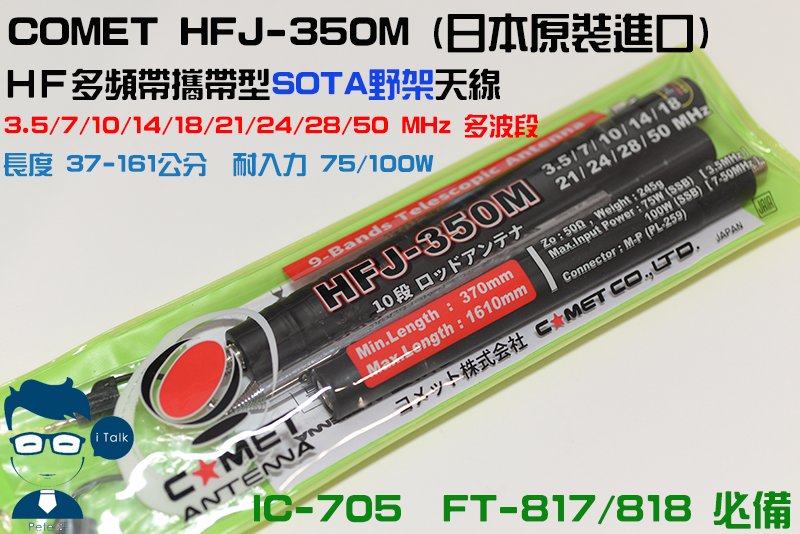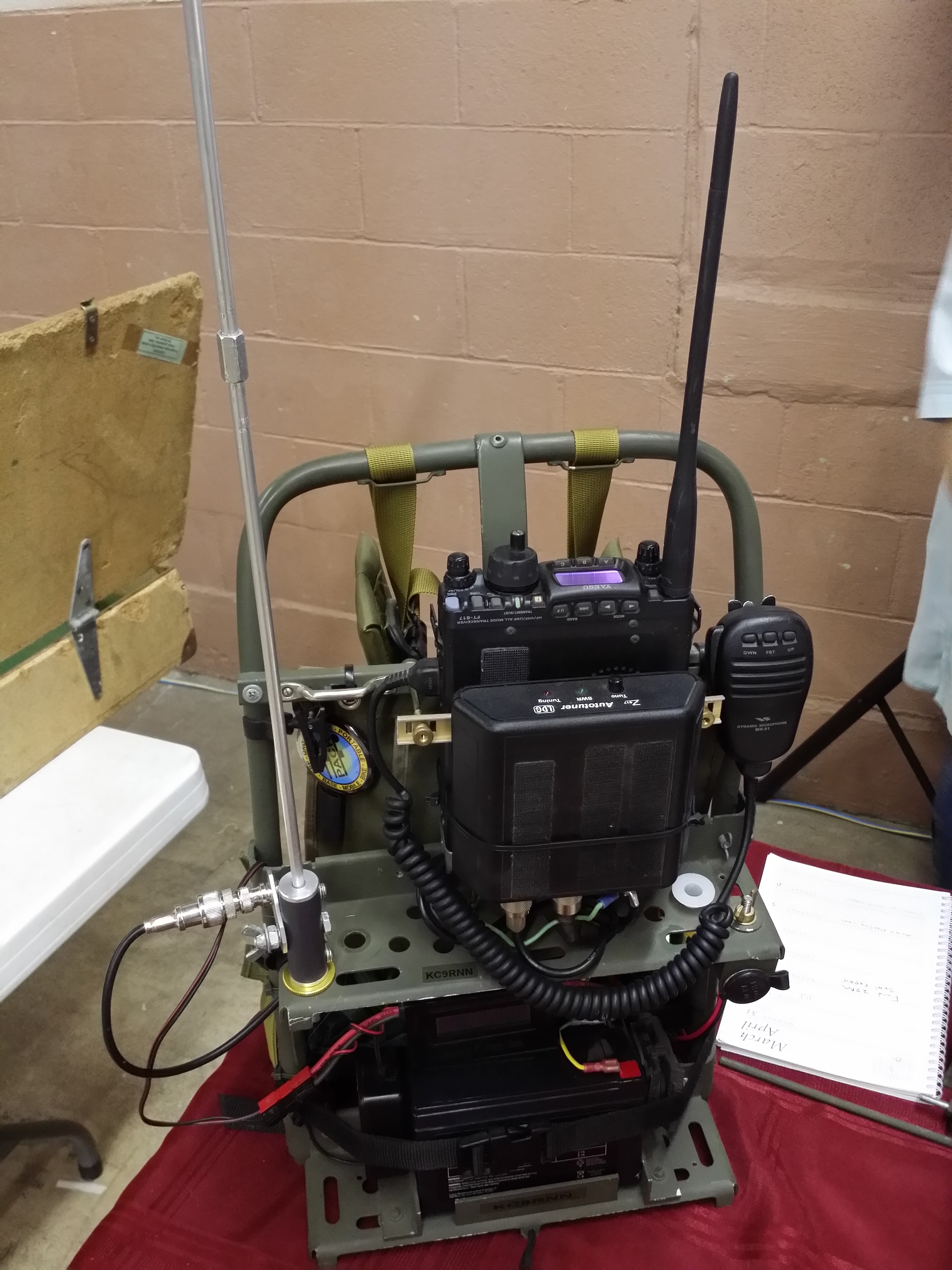The “Be Active” ham radio portable machine “IC-705” that covers the HF to 450MHz band in all modes including DV (D-STAR digital voice) exhibited by Icom at this year’s “Ham Fair 2019”. Recent news is that retail price was 124,800 yen ($1150 USD) and the scheduled launch date was announced for March 16, 2020. Icom expects to sell 10,000 units world wide on initial release. It is expected to sell for 100,000 yen ($925 USD) discounted by the Akihabara Ham shops. Icom held a pre-viewing event for IC-705 in Nihonbashi, Osaka on Saturday, December 21 and in Akihabara, Tokyo on Sunday, December 22, 2019
This is what we learned from the two events:
The standard accessories of the IC-705 do not include the VHF/UHF whip antenna, antenna conversion connector, and battery charging AC adapter. In addition, the announcement revealed that a tripod screw hole is provided on the bottom of the IC-705, and that the micro USB terminal has two COM ports. More comments below the product overview:

The IC-705 uses the RF direct sampling method, which is highly evaluated by the IC-7300 / IC-9700. A variety of functions including a real-time spectrum scope and waterfall display, which boast the highest speed and resolution, are realized in a lightweight 1kg (including the attached lithium-ion battery BP-272) and compact body. In addition, a large 4.3-inch color display that supports touch operations allows you to intuitively operate various functions.

In addition, a maximum output of 5W is achieved with the included battery (BP-272) and a maximum output of 10W with an external power supply (at 13.8V). In addition to supporting connection using WLAN / Bluetooth wireless technology, it is also equipped with a GPS antenna, micro USB connector, and microSD card slot. Of course, it supports DV (digital voice) mode of digital communication D-STAR for amateur radio recommended by JARL (Japan Amateur Radio Federation). Fully equipped with D-STAR functions including terminal mode / access point mode.
A multi-bag backpack LC-192 (optional), ideal for movement and field operation, is also available.
<Main features>
- Covers HF + 50MHz + 144MHz + 450MHz in all
modes. From HF to 50/144 / 450MHz, you can enjoy various bands in DV mode of D-STAR in addition to SSB, CW, RTTY, AM, FM.In addition, reception covers continuously from 30kHz to 144MHz band.You can enjoy receiving FM broadcasts and air bands.
- Adopt RF direct sampling method Adopts RF direct sampling method that
directly converts RF signals into digital signals and processes the signals with FPGA (Field Programmable Gate Array).In the process of analog signal processing, there is no non-linear distortion that occurs in mixers, achieving extremely excellent phase noise characteristics and realizing a real-time spectrum scope and waterfall that boasts high speed and high resolution for the first time in its class. (Down conversion IF sampling method for 25MHz or more)
- Equipped with a real-time spectrum scope and waterfall
The performance and functions of the highly acclaimed IC-7300 and IC-9700 scopes are inherited as they are.Visually grasp band conditions, check available frequencies, and enable advanced operations beyond conventional field operations.
- Equipped with a large color display for touch operation A large color display of the
same size <4.3 inches> as the IC-7300 and IC-9700 is adopted. Various items can be set intuitively by touch operation. The visibility and operability in the field are dramatically improved.
- Lightweight & compact The
performance and functions approaching thebodyfixing machine are stored in a compact size of about 20cm in width, 8.35cm in height and 8.2cm in depth. Weight is about 1kg (including rechargeable battery BP-272, excluding antenna). We realize size and lightness that we can hold in one hand.
- Lithium-ion battery (BP-272) and external power supply (13.8V)
can be used. Lithium-ion battery BP-272 (supplied) can beused withhandy transceiver ID-51 and ID-31 series. Of course, it supports external power supply (13.8V).


- A maximum output of 5W with the attached battery and a maximum output of 10W with
an external power supply (at 138V) A maximum output of 10W (at an external power supply of 13.8V) despite being a portable machine. When using the attached lithium ion battery BP-272, operation with a maximum output of 5W is possible. It supports QRP (0.5W) as well as QRP (5W).
- Supports connection using
WLAN / Bluetooth wireless technologySupports connection usingWLAN / Bluetooth wireless technology. It can be used with a smartphone, remote control, and the optional VS-3 headset with Bluetooth technology.
- Equipped with GPS antenna and GPS logger Equipped with
high-performance GPS antenna.With D-STAR DV mode, you can send and receive location information while talking. This high-performance GPS realizes various functions such as a GPS log function and an automatic repeater list-up function. It is also possible to record the position of your own station in the communication recording file and to correct the time of the internal clock.
- Equipped
with amicroSD card slotRecord communication data, transmit audio, RTTY decode log, capture image of display screen, various settings of transceiver, save GPS and other data, as well as use for firmware upgrade and various programming Equipped with a microSD card slot that can be used.
- D-STAR function is also fully equipped The
DR function, terminal mode / access point mode, etc. are fully equipped with functions to enjoy D-STAR comfortably. In addition, you can send, receive, and view saved photos using only the IC-705 itself.
- Equipped with micro USB terminal
Two COM ports are provided.This makes it possible to control the rig and operate CW and RTTY simultaneously.Audio (modulation / demodulation) is also possible.
- Speaker microphone with
customization button included A speaker microphone withcustomization button <HM-243> is included. The speaker microphone is equipped with customization buttons that can assign frequencies, up and down, and various functions.
- Multi-bag LC-192 is ideal for moving and field operation.
Not only can you store the IC-705 neatly, but also the multi-bag LC-192 has a variety of functions, such as mounting an antenna and passing a coaxial cable or microphone cable. (option).It is designed to operate with the IC-705 in the bag.



<Accessories> -Speaker
microphone <HM-243>
-Lithium ion battery <BP-272 / 7.4V, 2000mAh (typ.)>
-DC power cable and others
NO antenna or battery charger is included
<Option> -BC
-202 Rapid Battery Charger: 4,800 yen ($45 USD)
-BC-217S AC Adapter (USB type, for battery charging): Price TBD
-CS-705 Programming Software: Free Download
-HM-243 Speaker Microphone: Price TBD
・ LC-192 Multibag : Price unknown
・ RS-BA1version2 IP remote control software: 8,500 yen (($85 USD)
・ ST-4001A Image Trimming Software (Android version): Free download
・ ST-4001W Image Trimming Software (Windows version): Free download
· VS-3 Bluetooth headset: 9,800 yen ($98 USD)
- A BNC Antenna connector was used for size restrictions and weight reduction
- A dedicated antenna tuner is in the works basd on the interst by customer feedback and surbeys but will not be released in March 2020
- SWR meter is an SWR readout only (No bandsweeps)
- A larger capacity battery beyond the BP-272 is being investigated based on customer feedback”. Why did you change the antenna connector to BNC type?
- Design is based on the KX3 and FT818 with a focus on operability
- Weight is 1KG due to aluminum diecast casing
- It is a direct sampling design up to 24Mhz then down conversion above that.
- Icom 705 is still undergoing design and testing stages
- Added D-Star to grow hobby among new hams
- Ground Lug was added
- Tripod socket was added to hold the radio in the backpack
- No current drain figures provided
- Feedback shows antenna tuner and amplifier of high interest
- USB port can be used to charge the battery
- Mobile brackets have been requested
- FT-8 mode will be supported with built in USB port
- Bluetooth will support 3rd party headsets
- Bandscope will be like the Icom 7300/9700
- It is not waterproof
- Alkaline AA cells not supported
- Radio does not have rubber feet
.More Reasons to buy the IC-705
Now I would like to give a few reasons why I want to buy the IC-705
Mobile and Base operation will be useful at 10 watts to a mobile antenna for VHF and UHF bands on FM and D-Star
The display is ideal and the bandscope function will be handy for checking band activity
Support for 2m and 70 cm SSB will aid in contesting and SOTA operations
For QRP portable and travel operations this radio is ideal and packed with new features. This becomes a multi-purpose radio
Because I want this radio
Antenna bits from the viewing

Diamond HFV40
7 to 430 MHz band broadband antenna “RHM10” (left) and 7 to 50 MHz band rod type antenna “RHM8B” employing a BNC connector.
Diamond RHM8B: 7-50MHz
Length: 0.5m – 1.78m (Division length: 0.38m) / Weight:285g
Max. power rating:120W (SSB) / Connector:BNC-P
Type:1/4wave reduced type (HF band),1/4wave (50MHz band)
Comet Comet Co., Ltd. is exhibiting a 1.8 to 1.9MHz band extension coil for 3.5 to 50MHz whip antenna “HFJ-350M” prototype with carry case
■3-50MHz 9 band rod element & tap antenna
- Jacket lead-style frequency tap change
●3.5MHz coil attachment
●Ten steps of rods for this type of antenna
●Approximately 245 g of light weight
Specifications
■Transmission frequency
3.5, 7, 10, 14, 18, 21, 24, 28-29.7 & 50MHz 9 band
■Impedance 50 Ω
■Input-resistant
7-50MHz 100W (SSB)
3.5MHz 75W (SSB)
■Connector M-P
■Full length (mm)- Approximately 370-1610
■Weight (g) – Approximately 245 g (at the time of 3.5MHz expansion coil connection)
■Single model 1/4λ with counterpoise

Prototype antenna mount. I have something similar for my Molle pack but SuperAntenna makes a suitable plate as well


Will fit in the backpack or even a vest pocket and a japanese version of the walkabout Antenna we have for our FT-817


Prototype carry case for the Comet tapped antenna

Diamond Screwdriver antenna mounted on the side using the custom plate

One hand radio


This HFJ-350M antenna seems very interesting

The Diamond HFV40 has been around for some time

A close up of the HFJ antenna

A plastic plate to hold the radio in using the tripod mount on the bottom

Ground lug looks very useful

Get the tripod out for mounting the radio in the car , on a shelf or in the backpack
90 Days away from purchase!


















































